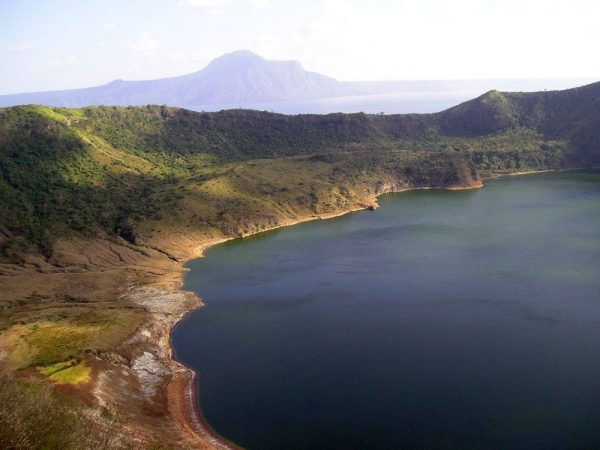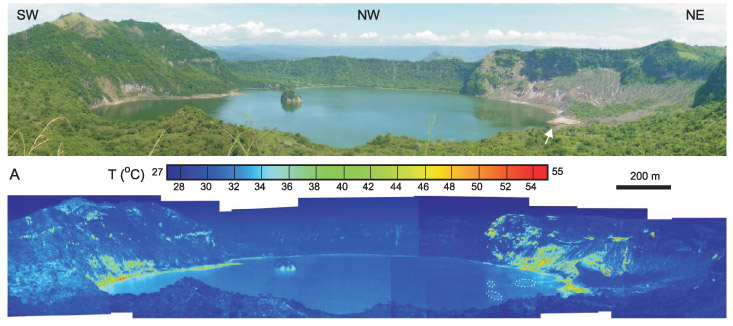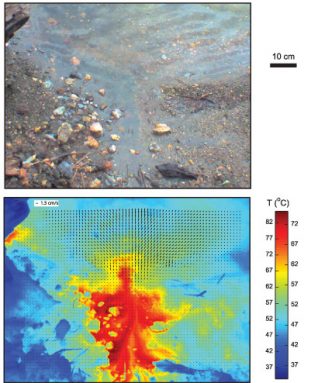Surprising hot springs
Scientists find shallow source of water for volcano’s hot springs
By Sid Perkins

For years, scientists had assumed that geysers and other types of hot springs spewed water that came from deep inside Earth. Now researchers working at a Philippine volcano have stumbled across an exception. Hot springs flowing into a lake in the volcano’s crater come from a shallow source — the lake itself. The new finding suggests there may be plenty of similar spots worldwide.
Temperatures deep below Earth’s surface are, on average, much warmer than at ground level. That’s true for a number of reasons. First, there is heat left over from when dust, gas and other material collided billions of years ago and formed Earth. The planet is still cooling off from those long-ago cosmic fender-benders.
Second, radioactive elements deep inside Earth are constantly generating heat. As each radioactive atom morphs, shedding subatomic particles (and sometimes transforming into other elements) it releases a tiny bit of energy. Add all those tiny bits together and there’s a lot of heat working its way upward through Earth’s crust.
That heat reaches Earth’s surface in different ways. Some is carried upward by molten rock, which spews from volcanoes or oozes through the seafloor at vents along mid-ocean ridges. Sometimes heat is emitted into space as infrared radiation; it’s the same sort of heat produced by an electric stove or a light bulb. (On average, each 10-square-foot area of Earth’s surface emits about half the power needed to light up a 4-watt nightlight.) Sometimes, Earth’s heat even flows forth in hot springs like those found at Yellowstone National Park and around many volcanoes.
Most scientists had presumed that water spewing from hot springs, like the source of heat itself, came from deep within the ground, says Bayani Cardenas. As a hydrologist at the University of Texas at Austin, he studies how water flows across and through Earth’s crust. But recent field tests by Cardenas and his coworkers have just revealed a new type of hot spring. It recirculates water coming from a source near Earth’s surface.
While describing his discovery at a meeting of geologists in November, Cardenas joked that his talk could have been titled: ”What I Did for My Summer Vacation.” When Cardenas isn’t teaching, he sometimes returns to his hometown in the Philippines. While there, he looks for opportunities to do research.
On a recent trip home, he visited nearby Taal volcano, which last erupted about 40 years ago. Still active, this volcano is peppered with instruments that measure seismic activity and other aspects of the changing landscape (such as changes in the slope in and around its crater). “That volcano is one of the most monitored in the Philippines,” Cardenas notes. “I went there mostly for curiosity. I knew if I went there, I’d find something interesting.”

He brought with him a thermal infrared camera. It detects and records radiation that corresponds to heat, not visible light.
Like many volcanoes, Taal’s crater holds a large lake. It covers about 1.3 square kilometers (an area larger than 240 football fields crammed together). The lake water averages about 35 meters deep (about the same as a 10-story building). When Cardenas looked at the lake using the thermal camera, he saw that the water at some spots along the lakeshore was much warmer than elsewhere. The average temperature of the lake was about 35° Celsius, just a little cooler than the body temperature of people. But at some spots where hot springs were flowing into the lake from sites onshore, the lake was far warmer — a very toasty 50° to 60° C (between 122° and 140° Fahrenheit).
On subsequent trips, Cardenas and his team brought instruments that let them measure the water flow through the ground along the lake. That’s when they got their surprise. Their data showed the water wasn’t flowing from deep underground. Instead, it was being pulled from the lake through the volcano’s rock. Some were very hot and warmed the water. The heated water then emerged from spots near the lakeshore and flowed downhill back into the lake.
The researchers used computers to predict the hot spring’s water movement. Those analyses now indicate that even a small amount of heat deep within Earth could fuel such recirculation from the lake.

“This is the same sort of circulation seen at deep-sea hydrothermal vents,” explains Cardenas. There, he notes, hot, mineral-rich water spews from the seafloor. This causes a suction that pulls cool seawater into cracks in the seafloor far from the vent. That water is warmed as it flows through the rocks beneath the seafloor and toward the vent; this is the opening from which the water returns to the sea as a potentially scalding stream.
Until now, no one had really studied the flow of hot springs around volcanoes before, Cardenas says. But the new finding may not be unique. Cardenas and his team suspect that the circulation they witnessed at Taal may occur in hot springs elsewhere.
“This is a nice piece of work and a novel finding,” says Steven Ingebritsen. He’s a hydrologist at the U.S. Geological Survey in Menlo Park, Calif. “This team has combined field data and computer modeling in a rather insightful way,” he adds. “This certainly gives hydrologists something new to talk about and to look for elsewhere.”
That such hot springs might be widespread is interesting, says Michael Manga. As a volcanologist, the University of California, Berkeley, scientist studies volcanoes. Many people are familiar with hot springs near volcanoes. However, they may be familiar only with what happens at the surface, he says. This study shows “there are all sorts of things that are new and poorly understood,” Manga notes.
Power Words
atom The smallest possible unit of a chemical element. This basic unit of matter is made up of a dense nucleus that is orbited by a cloud of negatively charged electrons. The atomic nucleus contains a mix of positively charged protons and electrically neutral neutrons (except in the case of the simplest hydrogen atom, which contains one proton and no neutrons).
computer modeling The use of computers to simulate physical processes. Scientists can use detailed models to simulate processes such as atmospheric circulation, long-term changes in climate and the flow of ocean currents, to name just a few examples.
crust The outermost layer of Earth, which typically ranges between 5 kilometers and 50 kilometers thick. The thinnest and most dense crust is found beneath the oceans, and the thickest and lightest portions of the crust are the continents.
hydrologist A scientist who studies the flow of water over Earth’s surface and through its crust.
hydrothermal vent Usually found on the seafloor in volcanically active regions, these portals typically spew hot water that’s full of dissolved minerals. When the mineral-rich water flows into the cool seawater, the minerals crystallize and form clouds of dark particles that give many vents the nickname “black smokers.”
infrared light A type of radiation not visible to the human eye. It is emitted from warm objects and can be felt as heat.
radioactive decay The process in which an unstable atom loses energy and breaks apart, either by splitting into smaller, more stable fragments or by emitting subatomic particles.
subatomic particles Particles that are smaller than atoms. These include particles emitted by the radioactive decay of unstable atoms, including negatively charged electrons, positively charged protons and alpha particles (which are made of two protons and two neutrons).
volcanologist A scientist who studies volcanoes, including how they form and how they behave before, during and after eruptions.







